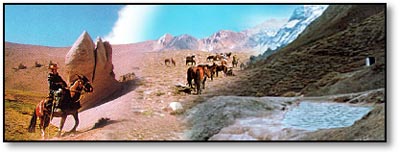
Explorations
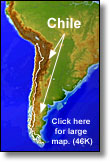 The Lake
District
The Lake
District
South of Chile's Biobio River begins a land where earth and
water play liberally together, producing visions of startling natural beauty. Known as the
Lake District, it is a region where azure, mirrored lakes hold the reflections of
ice-capped volcanoes, ancient trees and, of course, the indomitable Andes. It is little
wonder that the Mapuche Indians fought the Incas and the Spanish back across the Biobio
during the 15th and 16th centuries: such a land would be hard to surrender.
There are twelve principal lakes in the district, though dozens more fill the gaps and
valleys between the main waters. Many are joined by rivers and streams, which along with
the lakes ofter some of Chile's best freshwater fishing. Six volcanoes run through the
district from north to south, the highest being Villarica at 2,847 meters. The Lake
District is also an ideal embarkation point for Argentina: the region has four passes that
lead through the Andes.
 Atacama Desert
Atacama Desert
The coastal Atacama desert is the driest in the world and almost totally barren. The
landscape of the moon offers an obvious comparison, except that the Atacama has as its
backdrop the towering Andes, which block tropical storms from the Amazon Basin to the
east. During the time of El Nino (changes in circulation of the sea surface occurring an
average every seven years) there can be torrential rains in some areas of the desert,
causing flash floods and sudden, ephemeral bursts of vegetation.
Chiloe
Chile's largest island is endowed with a long coastline, thick forests, an excellent water
supply, and numerous small farms. It is steeped in myth and tradition, as well as in
perpetual fog.
Though the island lies only a few kilometers off the mainland, it has a curious history of
isolation that contributes to its rustic charm. Martin Ruiz de Gamba claimed it for Spain
in 1567 and established a small outpost there. When the Mapuche (never shy about disputing
territorial decisions made by foreigners) drove the mainland Spanish north of the Rio
Biobio in 1598, Chiloe's 200 Spaniards were marooned on the very turf they had claimed.
Throughout the 17th century, only one ship a year visited from Lima, and Dutch pirates
attacked the island twice. When a particularly bad earthquake struck in 1646, the settlers
had had enough, and they asked the Viceroy in Lima if they could leave. The Viceroy
declined the request. Despite such egregious treatment, the colony maintained a kind of
warped devotion to Spain, eventually becoming the last supporters of the crown in South
America.
Although Chile won its independence from Spain in 1817, after a seven-year war, Chiloe
refused to surrender to the mainland until 1826. Before doing so, however, they first
asked Britain if the island could become part of its empire. Britain declined the request.
Chile's National Parks
Juan Fernandez Islands: Encountered in
1574 by Juan Fernandez, these three islands sit in the Pacific about 670 kilometers west
of Valparaiso. Once a haven for pirates, since 1935 they have been a refuge for unusual
flora and fauna, many of which are indigenous only to the area (16 of the 87 classes of
plants and 101 of the 140 plant species). The sole indigenous mammal is the Juan Fernandez
fur seal, rescued from the brink of extinction in the last century. The Juan Fernandez
hummingbird stands out amongst the 11 resident bird species.
Though the islands and some of their animals are named after Fernandez, the most legendary
figure associated with them is Alexander Selkirk, the unfortunate and resourceful Scottish
castaway who inspired Daniel Defoe's Robinson Crusoe. Selkirk was marooned on Matasiera
(now called Isla Robinson Crusoe) in 1704 and lived alone in a cave for four years before
being rescued by two British privateers. Though his hardship and isolation must have been
physically and spiritually excruciating, his story has a partially happy
ending--upon his return to England he became a celebrity.
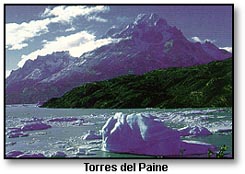 Parque Nacional Torres del
Paine: The tall granite pillars of the Torres del Paine, seemingly
reaching for the sky above the Patagonian steppe, are just a few of the main attractions
of South America's foremost national park. The towers, some of which are over 2,600 meters
high, drop abruptly into a valley bursting with sparkling blue lakes,
Parque Nacional Torres del
Paine: The tall granite pillars of the Torres del Paine, seemingly
reaching for the sky above the Patagonian steppe, are just a few of the main attractions
of South America's foremost national park. The towers, some of which are over 2,600 meters
high, drop abruptly into a valley bursting with sparkling blue lakes,
tumbling creeks and rivers, cascading waterfalls, huge glaciers, impenetrable forests, and
copious plant and animal species. Torres del Paine is one of those places on the planet
where the hand of nature has been especially creative.
The rich and apparently limitless nature of Parque National Torres del Paine provides an
ideal environment for observation and exploration. The 180,000-hectare park has been
designated as a UNESCO Biosphere Reserve, protecting the guanaco that graze on the open
steppes and the shy Chilean deer. Birds are especially abundant, with 105 species,
includingnandues (a type of small ostrich), flamingoes, bandurrias, condors, black-necked
swans, eagles, loicas and cachanas. There are also 25 different species of mammals like
the famous guanaco (and its cousin the llama), armadillo, fox, and an occasional puma.
Budding botanists can see over 200 kinds of plants, including forests of lenga and coigue,
which thrive in the microclimate created by the valley's protective walls.
Because of the park's incredible popularity, its natural beauty is especially threatened
by human intrusion. Its future literally rests in the hands of its visitors, who are asked
to keep to the many high-quality trails and to refrain from taking away with them any
natural souvenirs.
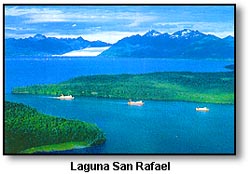 Parque Nacional Laguna San
Rafael: A birthplace of icebergs, Parque Nacional
Laguna San Rafael is where the northern Patagonian ice sheets falls into the sea in
riveting, neon blue glory. The icefield is actually composed of 19 major glaciers,
which are slowly being licked away by the area's mild temperature. But not to worry: the
ice should be around for a few thousand more years.
Parque Nacional Laguna San
Rafael: A birthplace of icebergs, Parque Nacional
Laguna San Rafael is where the northern Patagonian ice sheets falls into the sea in
riveting, neon blue glory. The icefield is actually composed of 19 major glaciers,
which are slowly being licked away by the area's mild temperature. But not to worry: the
ice should be around for a few thousand more years.
Laguna San Rafael is also home to some wonderful wild life. The park's dense forests hide
mammals that include pudu, pumas and foxes, while the glacial areas provide an ideal
enviroment for Magellanic penguins, albatrosses, otters,
and sea lions.
Reserva Nacional Cerro Castillo: The captivating centerpiece of
this reserve is the thrilling Cerro Castillo itself: a magnificent, basalt-pinnacled
mountain that resembles nothing so much as an enchanted castle. Three brilliant glaciers
on the mountain's southern slopes contribute to its mystical appeal. The reserve's 180,000
hectares are also home to some of South America's finest southern beech forests.
Parque Nacional Chiloe: Charles Darwin once passed through some of
the regions which later became this densely forested park, and scientists still study its
unique flora and fauna today. The park is situated along a stretch of Pacific Coastline
where penguins pace idyllic beaches, and its interior teems with sheltering coniferous and
evergreen forests. The Chilote fox, pudu, and over a hundred species of birds haunt the
coast and woodlands.
Parque Nacional Quelat: Parque Nacional Quelat is a landscape
carved and dominated by water. Its thin lakes rest between precipitous mountain walls like
hidden precious stones, and white-water rivers boil through the park's canyons and
evergreen forests. Quelat has the good fortune of being less frequented than some of
Chile's better known parks, though its mainstay, Ventisquero Colgante, or Hanging Glacier,
is among Chile's most breathtaking sights.
Parque Nacional Alerce Andino: Mountains as high and mighty as the
Andes should naturally be home to equally lofty trees, and Alerce Andino is where you can
find them. The park's Fitzroya cupressoides, familiarly called alerce trees, are among
Chile's natural treasures--the oldest is estimated to be 4,200 years old. The trees
resemble the giant sequoias of California and reach heights of up to 40 meters.
Parque Nacional Vincente Perez Rosales:
Chile's first national park, Vicente Perez Rosales is also one of its most inspiring. It
rests in the southern Lake District, where it is bordered on the east by dozens of
crystalline lakes and a stretch of the omnipresent Andes. To the north and west lies the
rest of the beautiful lake district as well as the volcanic
peaks of Puyehue and Osorno.
One of the park's major features are the emerald waters ofLago Todos los Santos, where
visitors can see the magnificent reflection of Osorno Volcano, with its gracefully
symmetrical cone. The volcano is ideal for climbing, although an ascent requires serious
ice climbing equipment. Guides can be obtained in nearby Puerto Varas and Puerto Montt.
During winter the park also has fine skiing.
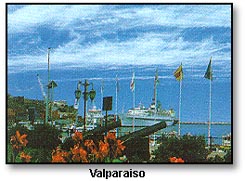 Valparaiso: With its crowning hills, labyrinthine
streets, and wide bay, Valparaiso is perhaps the most elegant city in Chile. It is the
country's second largest city, the seat of its parliament, and Chile's most important
coastal center. Before the completion of the Panama Canal evaporated its importance in
1914, Valparaiso was South America's most significant Pacific port and a major naval base
for the British Empire.
Valparaiso: With its crowning hills, labyrinthine
streets, and wide bay, Valparaiso is perhaps the most elegant city in Chile. It is the
country's second largest city, the seat of its parliament, and Chile's most important
coastal center. Before the completion of the Panama Canal evaporated its importance in
1914, Valparaiso was South America's most significant Pacific port and a major naval base
for the British Empire.
There are two distinct sections to Valparaiso; the modern coastal city that skirts the
bay, and the older, more residential neighborhoods that haphazardly cling to the cerros,
or hills. Connecting the heights and the shore is the city's most charming and fascinating
feature: 16 funicular railways known as ascensores. A ride on one of the ascesores to a
hilltop will grace the visitor with a splendid view of the recumbent city below, almost
all of which has been constructed during this century. Valparaiso's hills and railways are
not the only similarities it bears to California's San Francisco; over the last 90 years,
earthquakes have come and gone, one of them completely devastating the city in 1906--the
same year as San Francisco's Great Quake.
Copyright (c) 1998 interKnowledge Corp. All rights reserved.
 .
.